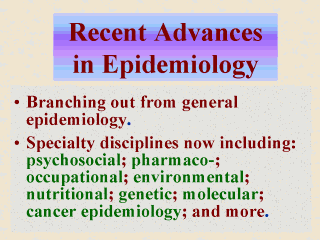| front |1 |2 |3 |4 |5 |6 |7 |8 |9 |10 |11 |12 |13 |14 |15 |16 |17 |18 |19 |20 |21 |22 |23 |review |
 |
Recent advances
in epidemiology that are pertinent to health risk assessment include several specialty
areas into which basic and intermediate-level general epidemiology have branched out.
These specialty areas include, but are limited to: pharmacoepidemiology, pyschosocial
epidemiology, occupational epidemiology, environmental epidemiology, nutritional
epidemiology, genetic epidemiology, molecular epidemiology, and cancer epidemiology. A course in general epidemiology, whether at the basic or intermediate level, typically teaches students how to measure disease occurrence and how to measure associations between exposures and outcomes (see, e.g., Gordis, 1996; Lilienfeld and Stolley, 1994; Rothman and Sander, 1998; Szklo and Nieto, 2000). Students in those courses are thus trained to measure incidence, prevalence, and their interrelation. Incidence and prevalence involve the number of new and existing cases, respectively, at a time point or during a time period. These rates and other measures of morbidity and mortality are primarily the objectives of descriptive epidemiology, in which the attempt is to characterize the amount and distribution of disease within a population. General epidemiology students are also given basic training in analytic epidemiology, in which several study designs are available as options to measure associations between exposures and outcomes. These study designs include case-control studies, cohort studies, cross-sectional studies, clinical trials, quasi-experimental studies, and ecological studies (see Slide 16 and references cited above for definition and description of these study designs). |